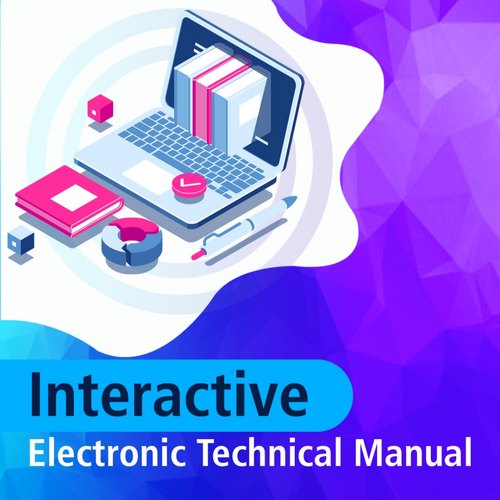IETM
Interactive Electronic Technical Manual

Expertise & Projects
IETM / IETP technology puts information where it’s needed faster and with ease of accessibility. Electronic manuals are the most efficient and cost-effective method to control, deliver and maintain data.
The Interactive Electronic Technical Manual (IETM) was first conceptualized in the1980’s as a means of compressing volumes of paper documents into easily portable and storable digital media or on line pages. These properties along with increased functionality of IETM software, inclusion of various media within the text and quick and easy access to the desired information has made the IETM the preferred choice.
The format and style of the presented information is optimized for presentation in electronic form, either on a desktop PC, laptop, or any other portable electronic display. The presentation format is “frame-oriented” not “page-oriented” as in paper documents. Multiple paths are provided for easy access to the required information.
We have over 2 decades of experience and can tailor an IETM to any standard to meet your requirements. An indicative list of major IETM Projects delivered to premier Defence PSUs / Suppliers is attached. Additional information on IETM is given as an attachment
Advantages of IETM’s
IETM’s are significantly superior to the traditional paper-based technical manuals in real world conditions.
Features of IETM’s that Improve Maintenance
Information access and presentation.
With IETM’s, all required information can be accessed by a click. The interactive visual presentation of complex procedures by using animations, video clips, virtual reality and expert system modules provide the maintainer with total comprehension of the task on hand.
Reduction in Time for Technical Information Update/Modification
Correcting and updating information on electronic media can be easily done through key text-searching capabilities. Changes made are applied globally eliminating the need for a separate change package for each stand-alone paper TM.
Maintenance Improvements
Areas where maintenance process improvements can be realized using IETM’s are:
- Shorter MTTR
- Greater productivity of technicians
- Reduction in time for updating and correcting discrepancies in maintenance
- manuals
- Reduction in time spent on maintenance paperwork
Class / level of IETM
Paper (Level 0)
- Traditionally printed technical manuals that are only delivered as paper manuals.
Electronically Indexed Page Images (Level 1)
- These electronic documents are page raster images that have been scanned, not live text. They may link from the Table of Contents to specific pages, and are very inexpensive to produce.
Electronic Scrolling Documents (Level 2)
- Level 2 manuals are page-oriented live ASCII text with SGML/XML tags. They may use hypertext links to other related areas within the document, and can include multimedia.
Linear-Structured IETMs (Level 3)
- Level 3 technical manuals are made of linear-structured information that use HTML, SGML or XML, yet still resemble paper documents. Level 3 technical manuals are most often viewed as indexed PDF files.
- The difference between IETM Class II and Class III is analogous to the difference between PDF book and a web site. The book structure is discarded; instead the document is structured more freely following the logic of the content. The document can still be printed but it won’t necessarily match the presentation on the screen. Hyper linking throughout the document is expected. The document would be authored in a markup language, typically SGML.
Hierarchically Structured IETMs (Level 4)
- Level 4 IETMS are hierarchically structured manuals and are specifically authored for interactive electronic presentation. They allow for robust cross-referencing between data. Level 4 IETM data is commonly tagged using SGML or XML and stored in a relational or object-oriented database.
- Obtaining benefits of data integrity and removal of data redundancy. Relationships in the content that are presented as hyperlinks are mapped directly to relations in the database schema. Redundancy in the data that exists in earlier classes should be removed. The sequence of presentation is also different that earlier classes This class now expects the data to be stored in a relational database,. There is no longer the concept of a static page. Content can change dynamically based on user’s navigation and input through the content; the content may now be user specific. It is no longer possible to print a linear format of the document.
Integrated Process IETMs (Level 5)
- The Integrated Process IETM lets a user interact with the technical manual, and in turn, the manual interacts with different processes. The processes may include expert systems, computer based training modules, interactive schematics, test equipment, prime equipment diagnostics, intrusive or remote diagnostics, etc., often exhaustive manuals are created and implemented.
- In this class the documentation is now integrated with expert systems that may influence the display of content. For example, the IETM system may aggregate data from a large number of users input; feed that to the expert system that analyzes it and then the result gets fed back to the user through the IETM system. An analogy might be Google search, where search results are improved based on analysis of large data sets of previous queries entered by users.
Tools and Standards
Publishing / Authoring Tools (IETM):
- Generator’s
- Adobe FrameMaker
- PTC Arbortext
- Adobe PDF Writer
- XML Editor
- Visual Studio – (.NET, C#)
